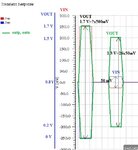hannover90
Member level 4
Hello all,
I have a problem to understand fully differential amplifiers and also their CMFB.
I learned from theory vout2-vout1=A*(vin2-vin1) and the gain (A) is infinite.
But I don't understand, how would be the output signals of a FD-Amp with supply voltages of -1.7 V and 1.7 V and an output common-mode voltage of 0.8 V regarding the input signals, as attached?
How high should be the gain?
.
I have a problem to understand fully differential amplifiers and also their CMFB.
I learned from theory vout2-vout1=A*(vin2-vin1) and the gain (A) is infinite.
But I don't understand, how would be the output signals of a FD-Amp with supply voltages of -1.7 V and 1.7 V and an output common-mode voltage of 0.8 V regarding the input signals, as attached?
How high should be the gain?
.

